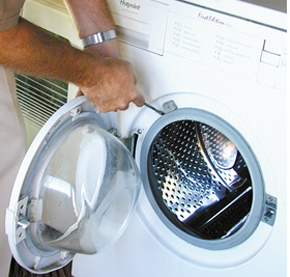If you prefer, you can email us as well for an washer repair appointment in Brooklyn, Queens or Bronx. In the email please include your name, phone number, zip code and brief details of the problem that you are experiencing with your washer. As soon as we receive the email we will contact you, so that you can schedule your washer repair appointment in Queens, Brooklyn or the Bronx.
We service and repair all washer brands and models:
- Maytag
- Magic Chef
- Montgomery Wards
- Hotpoint
- Jenn Air
- Kenmore
- Kitchen Aid
- GE
- Whirlpool
- Speed Queen
- LG
The information below will help you to become more familiar with your washer. It will also help you to use your washer in the most effective and efficient ways. This way you will be able to save money on utility expenses and to extend the life of your washer.
IMPORTANT: Do not try to use your own skills and get involved in any washer repairs that you are not familiar and experienced with. Ninety-nine percent of the time when you repair washer you deal with water and electricity and if you don’t know what you are doing this could be a dangerous mix. It could literally kill you! Do not take chances with your safety. The information below is strictly for educational purposes. We strongly encourage you not to getting involved with any washer repairs on your own. All washer repairs demand experience and professional training with gas or electrical systems and can become very dangerous if you don’t have the knowledge for repairs. For professional help washer repair in Queens, Brooklyn or the Bronx call us any time at:
MORE ABOUT YOUR WASHER
When replacing a prior washer, do make sure you use the new washer hose connectors which come with the washer. Do not reuse the old washer hoses from your old washer. The hose connectors are your washer life line to the hot and cold water you need to clean clothes. The water taps at the other end of those washer hoses are turned on high. If a hose bursts, your house will be flooded.
Some retailers remove the hose connectors from the washing machine box and sell them as parts. You bought new hose connectors as part of the washing machine. Demand that the retailer give you new hose connectors. You paid for them. If you install the washing machine yourself, do read the installation instructions and the service manual carefully. If you have the washing machine installed by an appliance repair technician watch him careful. He can teach you a hundred things while he is installing the machine. You want to take special care to learn how to open up and does minor service oil the equipment.
• You are causing undo strain on all the mechanical washer parts.
• You are not permitting enough water to wash through the clothing. While cleaning, this means that enough detergent is not getting to the clothing to do a good job. While rinsing, it means that enough clear water is not getting to the clothing to rinse away the washer detergent.
• You are causing a tremendous amount of extra wear and tear on
your clothing. The cloth should be rubbing against water, not rubbing other clothing.
• You are reducing the service life of your washer by three or four years.
Instead of overloading the washing machine, make a practice of washing under loading the machine. All it is costing you is a little extra water and a little extra time. For the cleanest, brightest clothing, a good rule of thumb is: two loads are better than one. Use the hottest water your fabric will allow. The hotter the water, the more active your detergent will be. The more active the detergent, the less you have to use and the cleaner your clothing will be.
Check the washer water cycle temperature. Never let the warm water cycle be lower than 100" F. Any lower and your clothes won't clean. Adjust the hot and cold water valves to provide the proper hot water input. You will have to recheck the temperatures and readjust the water every winter. Hopefully you have taken this advice and gotten a machine with manual controls, usually dials for the type of wash, etc. No matter what type of washer controls you have, follow this rule: Never move the dials while the machine is running. Switching the washer from one setting to another during the cycle will give the machine a "nervous breakdown.” Even with washer mechanical dials it is easy to get in trouble. Controls go bad quite often and it is almost always the fault of (lie consumer. Never turn the washer dials fast. Never turn the dials backward you are sure to break something. My advice on moving a washer from one location to another is simple: Don't Well, maybe that is a little drastic.
What I mean is that if you want to move a washer from here to there, you really should take about 24 hours off to think about it. Once a washing machine is leveled and set up, moving it to another location can cause big problems after reinstallation. When moving washer to your new home, remember, to function properly the washing machine must be very solid and perfectly level. Jarring the machine while moving, could upset the delicate balance of the machine and break some parts.
Above all: Never lay a washing machine on its side just a second of that is enough to break washer stability parts or plastic tub parts that will ruin the washer and cause flooding in the laundry room.
One final note about washing machine operation.
Washing machines are usually located in basements. Basements are the areas in the house most prone to be damp or flooded.

